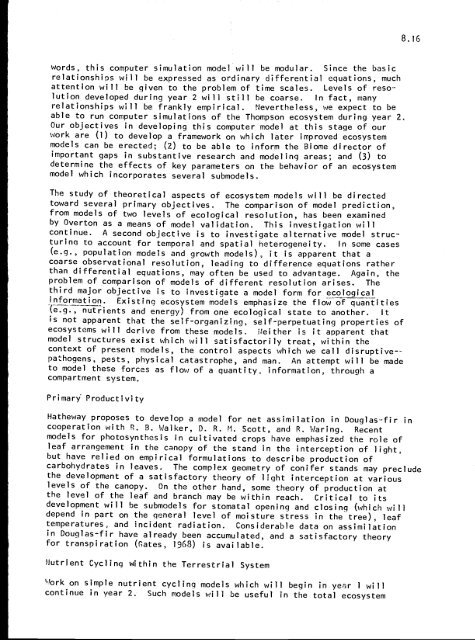FOREST BIOME - ScholarsArchive at Oregon State University
FOREST BIOME - ScholarsArchive at Oregon State University
FOREST BIOME - ScholarsArchive at Oregon State University
Create successful ePaper yourself
Turn your PDF publications into a flip-book with our unique Google optimized e-Paper software.
words, this computer simul<strong>at</strong>ion model will be modular. Since the basic<br />
rel<strong>at</strong>ionships will be expressed as ordinary differential equ<strong>at</strong>ions, much<br />
<strong>at</strong>tention will be given to the problem of time scales. Levels of resolution<br />
developed during year 2 will still be coarse. In fact, many<br />
rel<strong>at</strong>ionships will be frankly empirical. Nevertheless, we expect to be<br />
able to run computer simul<strong>at</strong>ions of the Thompson ecosystem during year 2.<br />
Our objectives in developing this computer model <strong>at</strong> this stage of our<br />
work are (1) to develop a framework on which l<strong>at</strong>er improved ecosystem<br />
models can be erected; (2) to be able to inform the Biome director of<br />
important gaps in substantive research and modeling areas; and (3) to<br />
determine the effects of key parameters on the behavior of an ecosystem<br />
model which incorpor<strong>at</strong>es several submodels.<br />
The study of theoretical aspects of ecosystem models will be directed<br />
toward several primary objectives. The comparison of model prediction,<br />
from models of two levels of ecological resolution, has been examined<br />
by Overton as a means of model valid<strong>at</strong>ion. This investig<strong>at</strong>ion will<br />
continue. A second objective is to investig<strong>at</strong>e altern<strong>at</strong>ive model structuring<br />
to account for temporal and sp<strong>at</strong>ial heterogeneity. In some cases<br />
(e.g., popul<strong>at</strong>ion models and growth models), it is apparent th<strong>at</strong> a<br />
coarse observ<strong>at</strong>ional resolution, leading to difference equ<strong>at</strong>ions r<strong>at</strong>her<br />
than differential equ<strong>at</strong>ions, may often be used to advantage. Again, the<br />
problem of comparison of models of different resolution arises. The<br />
third major objective is to investig<strong>at</strong>e a model form for ecological<br />
inform<strong>at</strong>ion. Existing ecosystem models emphasize the flow of quantities<br />
(e.g., nutrients and energy) from one ecological st<strong>at</strong>e to another. It<br />
is not apparent th<strong>at</strong> the self-organizing, self-perpetu<strong>at</strong>ing properties of<br />
ecosystems will derive from these models. Neither is it apparent th<strong>at</strong><br />
model structures exist which will s<strong>at</strong>isfactorily tre<strong>at</strong>, within the<br />
context of present models, the control aspects which we call disruptive-p<strong>at</strong>hogens,<br />
pests, physical c<strong>at</strong>astrophe, and man. An <strong>at</strong>tempt will be made<br />
to model these forces as flow of a quantity, inform<strong>at</strong>ion, through a<br />
compartment system.<br />
Primary' Productivity<br />
8.16<br />
H<strong>at</strong>heway proposes to develop a model for net assimil<strong>at</strong>ion in Douglas-fir in<br />
cooper<strong>at</strong>ion with P. B. Walker, D. R. M. Scott, and R. Waring. Recent<br />
models for photosynthesis in cultiv<strong>at</strong>ed crops have emphasized the role of<br />
leaf arrangement in the canopy of the stand in the interception of light,<br />
but have relied on empirical formul<strong>at</strong>ions to describe production of<br />
carbohydr<strong>at</strong>es in leaves. The complex geometry of conifer stands may preclude<br />
the development of a s<strong>at</strong>isfactory theory of light interception <strong>at</strong> various<br />
levels of the canopy. On the other hand, some theory of production <strong>at</strong><br />
the level of the leaf and branch may be within reach. Critical to its<br />
development will be submodels for stom<strong>at</strong>a] opening and closing (which will<br />
depend in part on the general level of moisture stress in the tree), leaf<br />
temper<strong>at</strong>ures, and incident radi<strong>at</strong>ion. Considerable d<strong>at</strong>a on assimil<strong>at</strong>ion<br />
in Douglas-fir have already been accumul<strong>at</strong>ed, and a s<strong>at</strong>isfactory theory<br />
for transpir<strong>at</strong>ion (G<strong>at</strong>es, 1968) is available.<br />
Nutrient Cycling Within the Terrestrial System<br />
York on simple nutrient cycling models which will begin in year 1 will<br />
continue in year 2. Such models will be useful in the total ecosystem
















